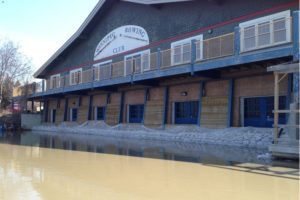Good water quality is an asset for rowing and is the focus of a commendable campaign by World Rowing and World Wildlife Fund. Quantity of water is discussed less frequently, but is equally important. It is top of my mind because I row in Winnipeg, Manitoba, Canada where we are having serious floods again this year, and I am running a rowing trip this October in California, where there is an equally serious drought.

WRC sandbagged against flooding Red River April 2014. Photo credit: Global News website
In Manitoba, terms such as “flood of the century”, “unprecedented” “one-in-300 years” are applied to separate flood events occurring with what feels like increasing frequency. Manitoba is largely flat, has severe winters, and is at the receiving end of vast watersheds originating as far away as the Rocky Mountains. Spring flooding is a fact of life here. Increasingly we are also suffering from summer flooding, and the volume of water is staggering. We are very fortunate to have excellent flood protection and water control infrastructure, especially to protect the city of Winnipeg. It works so well, that for most Winnipeggers, floods are an inconvenience. Those living in rural areas and smaller communities are not always so lucky. Flooding has caused enormous financial, emotional and health burdens on people, government and taxpayers of the province. The impact on rowers is minor in comparison, but when we are passionate about our sport and especially for those training to compete, it feels personally significant.

A long way down to Lexington Reservoir for Los Gatos Rowing Club. Photo credit: Los Gatos RC Facebook page
I know much less about the drought in California. When I was there this April running the test tour for the California Dreaming – San Francisco Bay rowing trip, water was a regular topic of conversation. Water level s of Lexington Reservoir have been dropping dramatically, meaning less and less water surface for Los Gatos Rowing Club and an incredibly long and steep access between the boathouse and the ever receding dock. Among Stockton rowers, plans to build massive tunnels under the ecological sensitive Delta area to carry water from the Sacramento River to Southern California are particularly intensely debated.
These are just two examples from North America. Think of the devastating droughts in the Horn of Africa, flash floods in Australia, forest fires from lack of water in the south of Europe and too much water and flooding in eastern Europe. It seems unlikely that there are many rowing venues that have avoided water quantity problems of one kind or the other. For example, the 2014 European Rowing Championships still took place in Serbia despite terrible and tragic flooding, and this winter, flooding on the Thames impacted rowing clubs, rowers and events in a multitude of ways.
Why are we experiencing such extremes and with what seems greater frequency and severity? There are many possible causes and even more opinions. Climate change is part of the mix. There are endless debates about the causes and what should be done, particularly at a global and national level. In addition to being a cause of climate change, human activities seem to be exacerbating the impacts of climate change. Increased summer flooding on the prairies may be linked to the drainage of wetlands for agricultural purposes and water consumption patterns in California are debated publically.
As rowers, what we can do?
- Exhorting time-pressed and information-overloaded people to read and learn more is likely not a winning strategy. However, paying a bit more attention is a good thing, especially when we are directly affected.
- Recognize our perspectives relative to usually greater needs and impacts, and participate in finding solutions, to whatever extent. If you donate to charities for humanitarian crises, perhaps select some that are water related. Participate in public engagement processes linked to water issues. Use social media to get the message out.
- Take personal action towards mitigating climate change – reducing your carbon footprint and encouraging our governments (and Canada is shamefully one of the worst) to take positive and strong action on climate change. This is usually seems overwhelming and we have been bombarded with exhortations of all that we should do. Why not start with using active transportation (bike, on foot) to get to the rowing club instead of driving, maybe even once or twice a week?


[…] rivers, which I have written about previously. I have also mused about the connection to water for rowers in terms of water quantity – either too much or too little. While we know that rowing is fabulous […]